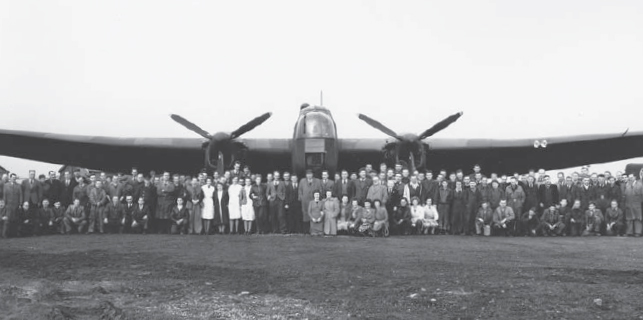
IT TOOK TIME FOR SS-Jaguar’s war effort to swing into action, but after six years a creditable output had been achieved. A new building in Foleshill, originally intended to produce Manchester bombers, and which dwarfed the original factory that SS had occupied since 1928, went on to build Wellington, Whitley, Stirling, Mosquito and Meteor aircraft frames and wings, along with thousands of components for other aircraft, and aero engines.
The buildings were bombed only once, in 1941, and even this damage was speedily repaired, so activity was continuous, and the variety of jobs tackled was enormous. Once the final pre-war build of new cars had been completed in 1939–40, there was no time to build new private cars, but a wide variety of sidecars, trailers and similar automotive add-ons kept the existing car-building expertise ticking over.
That was not all. On the rare occasions that they had any spare time, managers and engineers would sit down to consider the company’s future. Central to this was the decision taken, before the war ended, to drop the initials ‘SS’ from the company name (those letters had acquired sinister connotations from their use by the Schutzstaffel, the ruthless German paramilitary defence corps), so the name ‘Jaguar’, on its own, at last came to prominence.
Three other vital decisions were also made to underpin the company’s future: Jaguar would not develop its links with Motor Panels (that business would be sold); it would take over the six-cylinder engine-manufacturing equipment from Standard (which would nevertheless continue to supply four-cylinder units); and in the long term it would develop its own brand-new family of engines. This was the period when the famous XK engine was conceived, and when the power units that would power the company’s famous cars for the next forty years came into being. Although there was no time for prototypes to be built, or for cars to be tested at first, time was found to plan, to scheme, to discuss, and to make ready for the peace that would surely come.

During the Second World War Jaguar’s workforce produced many major components for the Whitley bomber.
At the height of the war, managers were obliged to carry out fire-watching duties at the Foleshill factory, in case of incendiary attack from enemy aircraft. Lyons made sure that a close-knit little group of people – himself, Bill Heynes, engine designer Claude Baily and development engineer Walter Hassan among them – were always rostered to work together on Sunday nights, when they found time to discuss all manner of engineering schemes for post-war models.
Because William Lyons had not latterly enjoyed working in harness with Standard (and particularly with Sir John Black), chief among these plans was the intention to design new engines. After much development work had been carried out, initially on paper, and eventually on the test beds, a closely related range of new four-cylinder and six-cylinder engines, all with twin-overhead-camshaft cylinder heads, spanning 2.0 litres (‘Four’) to 3.4 litres (‘Six’), was developed, and thus the XK range began its long and illustrious career. Although the ‘Four’ was launched in 1948, and occasionally seen in public thereafter, it was never put on sale, while the ‘Six’ became Jaguar’s general-purpose power unit, which could be put to a whole range of uses.
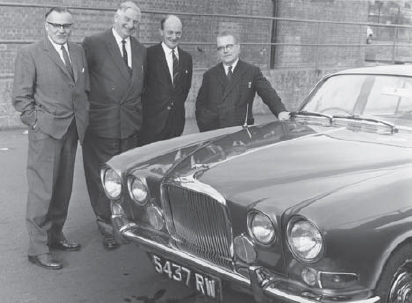
Bill Heynes, Walter Hassan, Harry Mundy and Claude Baily were all part of an illustrious Jaguar engine-design team in post-war years.
This, however, is to jump ahead a little. Immediately after the war ended in 1945, Jaguar (now without the ‘SS’) converted its factories back to civilian use, completed the installation of machinery to build the ex-Standard engines, and started to build private cars again. The elegant 1.5-litre, 2.5-litre and 3.5-litre saloons that had been produced in 1938 and 1939 were revived; drop-head coupé derivatives soon followed, and by 1948 production was again up to more than four thousand cars a year.
Then came the first true innovations. Although Lyons had originally wanted to introduce new chassis, engines and styles together, he was frustrated by post-war shortages and the need to join a queue for new-type bodies at his bodyshell suppliers, Pressed Steel. He also came to realise that it might be financially difficult to achieve everything at once.
In 1948, therefore, he pragmatically elected to introduce a brand-new chassis, complete with torsion-bar independent front suspension, and to phase in a new style of saloon (the Mark V) to sit on top of it, but to hold back the XK engine for the future. That was the original plan, but even before the Earl’s Court Motor Show of that year (the first London show to be held after the war) he also decided to rush through the development of a graceful new two-seater sports car, the XK120, which would become the first to use the twin-cam XK engine.

Launched in 1948, the Mark V featured a completely new chassis, with independent front suspension and this graceful five-seater body style, but still used the late-1930s type of overhead-valve engine.
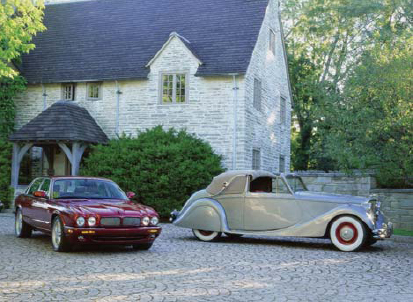
Jaguar also produced some Mark V drop-head coupés – this car being photographed, much later, alongside a 1998 XJR.
The appearance, and the potential, of the XK120, caused a sensation. Whereas the Mark V was something of a throwback to pre-war shapes and equipment, the XK120 was the sort of car that caused every red-blooded driver, whether British or foreign, to go weak at the knees. It was not merely that it looked sleek, and that it could exceed 120 mph (which made it a true supercar by post-war standards), but that it was to be sold at the astonishingly cheap price, in the United Kingdom, of £1,263.

The XK120 was an immediate success in overseas markets; this batch was destined for sale in North America.
Before long, not only had the XK120 proved every claim made for it, by winning production car races outright, and by achieving an authenticated 132 mph in a straight-line demonstration in Belgium, but it greatly exceeded every original estimate of sales. Jaguar had cautiously thought they might sell two hundred such cars, but they soon had to have the bodyshell retooled for bigger quantities, and more than twelve thousand were delivered in six years.
The next outstandingly pleasant shock came when the Mark VII saloon appeared in 1950. This was a car that combined the chassis of the Mark V with the XK engine, all hidden by a larger, but graceful-looking, six-seater saloon shell. It sold at an attractive price and could easily exceed 100 mph.
Now that the last trace of pre-war engineering had been cast aside – styles, engines and titles were all modern – Jaguar could export their cars with relish, particularly to the United States, where the ‘Jagwah’ (as it was pronounced there) was seen as simultaneously trendy and traditional. Starting from scratch in 1947, when just seven cars were sent to North America, Jaguar exported 1,050 there in 1949–50, and 3,339 in 1951–2. As more than six thousand cars a year were being produced for all markets, the factory at Foleshill simply could not accommodate any more, even though the original 40,000 square feet occupied in 1928 had expanded to 600,000 square feet.
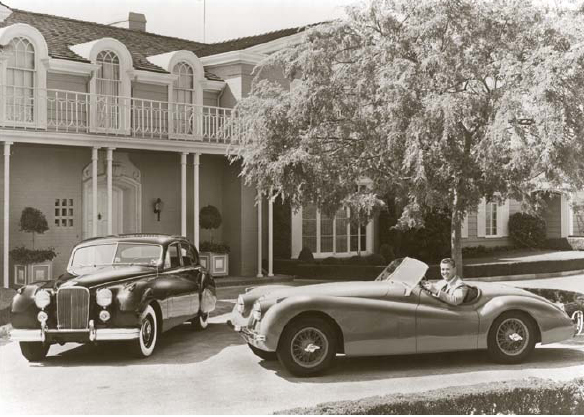
The Mark VII, which went on sale in 1950/1, was the first Jaguar saloon to use the famous XK engine. Although it was a large car (here it is compared with the XK120), it could exceed 100 mph with ease.
The search began for alternative or additional premises, especially when an application to the government to expand the Foleshill factory was turned down on planning grounds. However, this was not to be a repeat of the 1928 upheaval, when Swallow had been obliged to uproot itself from Blackpool and set down new roots in Coventry, more than 100 miles away. This time there was spare capacity in the city (mostly buildings used for war work that had rapidly been emptied after 1945), and Jaguar chose a former Daimler company factory in Browns Lane, Allesley, just 2 miles from Foleshill in another suburb of Coventry. The move, initiated in 1951, was eventually completed late in 1952, which gave the company more than a million square feet in which to work (which was swiftly filled). The older Foleshill plant was sold off (to Dunlop).

The Mark VII was the first Jaguar 100-mph saloon, but there would be many more to follow in future years.
Accordingly, at a time when Jaguar was already running flat out, with waiting lists building up all round the world, the big move took place. Somehow there were no major hiccups, and annual production immediately rose to more than ten thousand cars in 1952–3, and the company’s glamorous reputation continued to grow. This, the start of Britain’s new ‘Elizabethan age’, was a stimulating time to be in business, and Jaguar took every advantage of it.
Not only were the company’s two staple model ranges – the XK120 sports cars and the Mark VII saloons – extremely popular, but Jaguar had also begun winning world-class races, while other technical innovations continued to flow. Jaguar in racing is covered in another chapter, but the reason why the company’s road cars were so very successful must be emphasised here.
Continuity was the key factor, for Jaguar made certain that the same sure hand (and eye) – that of company founder William Lyons himself – would shape the new models for many years, and that the same engineering team, led by Bill Heynes, would oversee all the technical innovations. For these reasons, anyone with a sensitive eye for a line or a trend could easily relate the evolution of the XK family from one type to another – XK120 in 1948, XK140 in 1954, and XK150 in 1957 – and see where and how the racing C-Types and D-Types fitted in too.
In the meantime, the already famous XK engine was soon joined by super-powerful versions (the 3.4-litre engine was rated at 250 bhp when the D-Type racing sports car was revealed in 1954), and overdrive transmission, then automatic transmission, became increasingly popular optional extras, while all manner of work carried on behind the scenes. Disc-brake development was to be seen in one corner, independent rear suspension in another, and even an exotic 9-litre V8 engine project for a possible Ministry of Defence contract in yet another.
The most important advance, however, came in 1955, when the company introduced its very first unit-construction saloon car – the 2.4-litre model. After many years of producing strictly traditional-type Jaguars, all built around a separate chassis frame, it was time to move on. The existing cars had gradually grown slightly too large and too heavy, and the clientele was now clamouring for a smaller Jaguar again.
It was typical of Lyons that for this major investment he took advice where it was needed, but stayed loyal to his own company resources where possible. To make this new car, he would adapt Browns Lane to allow more cars to be built, he would style the compact four-door car himself, he would authorise the development of a smaller version of the XK engine (2.4 litres instead of 3.4 litres), but he would then rely totally on Pressed Steel of Oxford to engineer and manufacture the unit-construction (chassis-less) bodyshells to make it all possible.
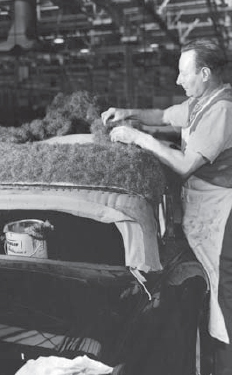
Even though Jaguar was building four to five hundred cars every week by the late 1950s, the craftsmen were still able to spend time on traditional methods of trimming the sports cars.
It was a huge gamble, but it succeeded. The new 2.4 went on sale in 1955, with a relatively unstressed 112-bhp/2.4-litre engine, but at a remarkably low price of just £1,299. Sales, and accordingly, production leapt ahead, passing twelve thousand a year in 1956 and looking set to rise in the future.
William Lyons had now been knighted – henceforth he was always officially and affectionately known as ‘Sir William’; an extremely fast derivative of the 2.4 – the 210-bhp 3.4-litre saloon model, which used a full-size XK engine – was almost ready for launch, and the third-generation XK sports car, the XK150, was also about to reach the showrooms; everything looked good for the burgeoning Coventry car-maker.
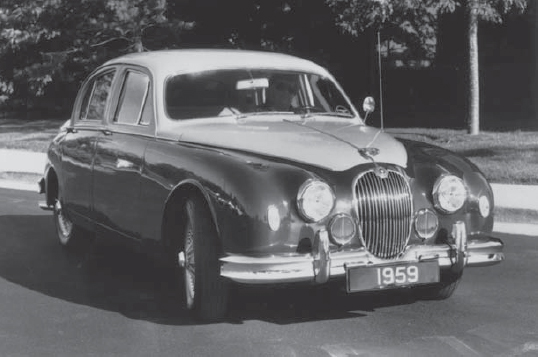
Jaguar announced its first ‘small’ unit-construction car in 1955, this being the 112-bhp 2.4-litre 2.4 model. When the larger-engined 3.4 was added to this range, it became Jaguar’s best-seller of the period.
But early in the evening of 12 February 1957, when all but a few staff had gone home, fire broke out at one end of the main assembly halls, rapidly consuming up to a third of the factory itself, wrecking the northern end of the assembly lines, destroying scores of newly built cars, and badly damaging many others. Luckily, no one was seriously hurt in this conflagration, but the business was badly hit.
Amazingly, rudimentary new assembly lines were opened up within days. Production forged ahead – it would reach 17,552 in 1957–8 – and the new models were launched as planned. It was typical of Jaguar’s determined spirit that within a year not only was the Browns Lane site back to normal, but the entire Jaguar operation was now developing as never before. It was almost as if the fire had acted as a barrier between the ‘old’ company and the ‘new’. In the next few years, not only would more and more cars be made, but sensational new models would be launched, Jaguar would absorb other famous companies, and it would eventually become part of another industrial colossus.

The most exclusive Jaguar road car of all time was the XK-SS of 1957. This was a slightly modified D-Type race car, and only eighteen such cars were originally produced.

For years, Jaguar’s principal problem with the E-Type was not in selling the cars, but in producing enough to keep up with the demand. This was Browns Lane in 1967.